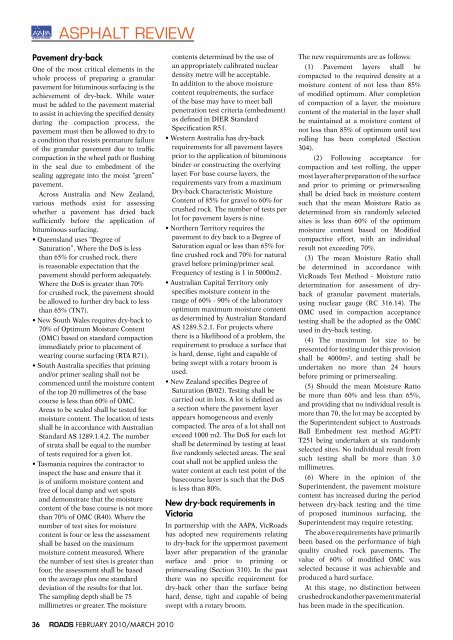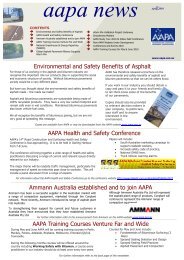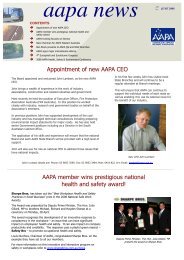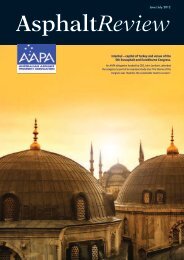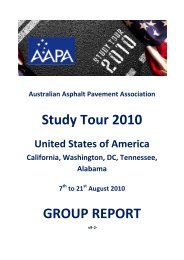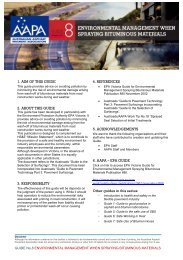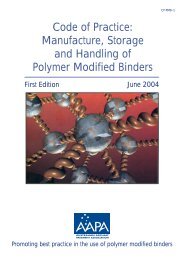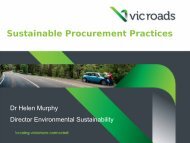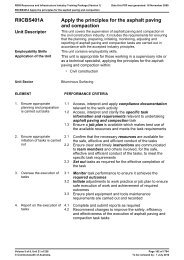Asphalt Review - Volume 29 Number 1 (February / March 2010)
Asphalt Review - Volume 29 Number 1 (February / March 2010)
Asphalt Review - Volume 29 Number 1 (February / March 2010)
- No tags were found...
Create successful ePaper yourself
Turn your PDF publications into a flip-book with our unique Google optimized e-Paper software.
ASPHALT REVIEWPavement dry-backOne of the most critical elements in thewhole process of preparing a granularpavement for bituminous surfacing is theachievement of dry-back. While watermust be added to the pavement materialto assist in achieving the specified densityduring the compaction process, thepavement must then be allowed to dry toa condition that resists premature failureof the granular pavement due to trafficcompaction in the wheel path or flushingin the seal due to embedment of thesealing aggregate into the moist “green”pavement.Across Australia and New Zealand,various methods exist for assessingwhether a pavement has dried backsufficiently before the application ofbituminous surfacing.• Queensland uses “Degree ofSaturation”. Where the DoS is lessthan 65% for crushed rock, thereis reasonable expectation that thepavement should perform adequately.Where the DoS is greater than 70%for crushed rock, the pavement shouldbe allowed to further dry back to lessthan 65% (TN7).• New South Wales requires dry-back to70% of Optimum Moisture Content(OMC) based on standard compactionimmediately prior to placement ofwearing course surfacing (RTA R71).• South Australia specifies that primingand/or primer sealing shall not becommenced until the moisture contentof the top 20 millimetres of the basecourse is less than 60% of OMC.Areas to be sealed shall be tested formoisture content. The location of testsshall be in accordance with AustralianStandard AS 1289.1.4.2. The numberof strata shall be equal to the numberof tests required for a given lot.• Tasmania requires the contractor toinspect the base and ensure that itis of uniform moisture content andfree of local damp and wet spotsand demonstrate that the moisturecontent of the base course is not morethan 70% of OMC (R40). Where thenumber of test sites for moisturecontent is four or less the assessmentshall be based on the maximummoisture content measured. Wherethe number of test sites is greater thanfour, the assessment shall be basedon the average plus one standarddeviation of the results for that lot.The sampling depth shall be 75millimetres or greater. The moisturecontents determined by the use ofan appropriately calibrated nucleardensity metre will be acceptable.In addition to the above moisturecontent requirements, the surfaceof the base may have to meet ballpenetration test criteria (embedment)as defined in DIER StandardSpecification R51.• Western Australia has dry-backrequirements for all pavement layersprior to the application of bituminousbinder or constructing the overlyinglayer. For base course layers, therequirements vary from a maximumDry-back Characteristic MoistureContent of 85% for gravel to 60% forcrushed rock. The number of tests perlot for pavement layers is nine.• Northern Territory requires thepavement to dry back to a Degree ofSaturation equal or less than 65% forfine crushed rock and 70% for naturalgravel before priming/primer seal.Frequency of testing is 1 in 5000m2.• Australian Capital Territory onlyspecifies moisture content in therange of 60% - 90% of the laboratoryoptimum maximum moisture contentas determined by Australian StandardAS 1289.5.2.1. For projects wherethere is a likelihood of a problem, therequirement to produce a surface thatis hard, dense, tight and capable ofbeing swept with a rotary broom isused.• New Zealand specifies Degree ofSaturation (B/02). Testing shall becarried out in lots. A lot is defined asa section where the pavement layerappears homogeneous and evenlycompacted. The area of a lot shall notexceed 1000 m2. The DoS for each lotshall be determined by testing at leastfive randomly selected areas. The sealcoat shall not be applied unless thewater content at each test point of thebasecourse layer is such that the DoSis less than 80%.New dry-back requirements inVictoriaIn partnership with the AAPA, VicRoadshas adopted new requirements relatingto dry-back for the uppermost pavementlayer after preparation of the granularsurface and prior to priming orprimersealing (Section 310). In the pastthere was no specific requirement fordry-back other than the surface beinghard, dense, tight and capable of beingswept with a rotary broom.The new requirements are as follows:(1) Pavement layers shall becompacted to the required density at amoisture content of not less than 85%of modified optimum. After completionof compaction of a layer, the moisturecontent of the material in the layer shallbe maintained at a moisture content ofnot less than 85% of optimum until testrolling has been completed (Section304).(2) Following acceptance forcompaction and test rolling, the uppermost layer after preparation of the surfaceand prior to priming or primersealingshall be dried back in moisture contentsuch that the mean Moisture Ratio asdetermined from six randomly selectedsites is less than 60% of the optimummoisture content based on Modifiedcompactive effort, with an individualresult not exceeding 70%.(3) The mean Moisture Ratio shallbe determined in accordance withVicRoads Test Method - Moisture ratiodetermination for assessment of drybackof granular pavement materials,using nuclear gauge (RC 316.14). TheOMC used in compaction acceptancetesting shall be the adopted as the OMCused in dry-back testing.(4) The maximum lot size to bepresented for testing under this provisionshall be 4000m², and testing shall beundertaken no more than 24 hoursbefore priming or primersealing.(5) Should the mean Moisture Ratiobe more than 60% and less than 65%,and providing that no individual result ismore than 70, the lot may be accepted bythe Superintendent subject to AustroadsBall Embedment test method AG:PT/T251 being undertaken at six randomlyselected sites. No individual result fromsuch testing shall be more than 3.0millimetres.(6) Where in the opinion of theSuperintendent, the pavement moisturecontent has increased during the periodbetween dry-back testing and the timeof proposed ituminous surfacing, theSuperintendent may require retesting.The above requirements have primarilybeen based on the performance of highquality crushed rock pavements. Thevalue of 60% of modified OMC wasselected because it was achievable andproduced a hard surface.At this stage, no distinction betweencrushed rock and other pavement materialhas been made in the specification.36 ROADS FEBRUARY <strong>2010</strong>/MARCH <strong>2010</strong>


